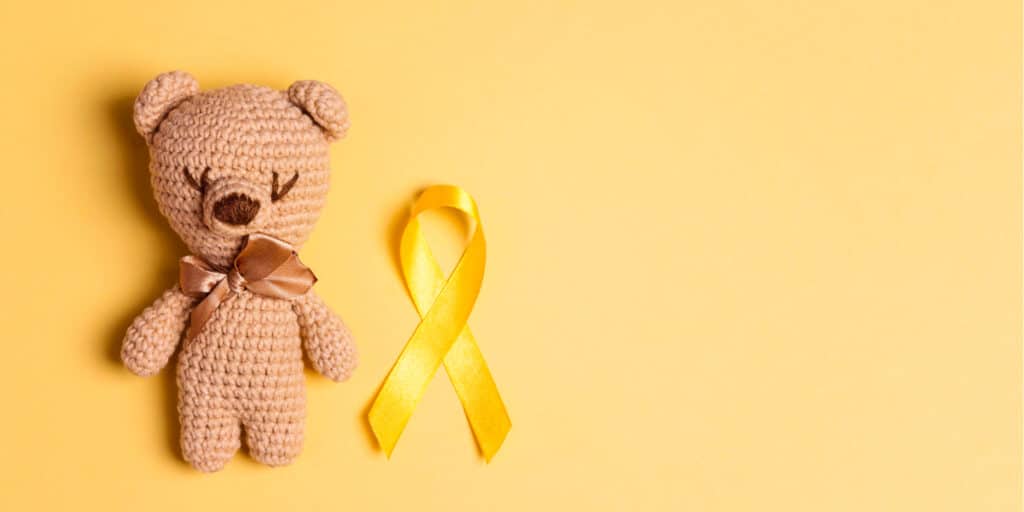September is Childhood Cancer Awareness Month. It is a time to recognize the children and families affected by childhood cancers and to help emphasize the importance of researching these devastating conditions. And it’s a big issue, because cancer is the leading cause of death by disease for children under the age of 14. With so many children being affected by cancer every year, Childhood Cancer Awareness Month is a great way to help raise awareness and educate others on just how serious it can be.
Childhood Cancer Awareness Month has been recognized nationally since 2012. The color gold and the golden ribbon are both symbols for cancer affecting children and have been used to help raise awareness during Childhood Cancer Awareness Month for many years. The term “Go gold for childhood cancer” has been a popular phrase used during September. This is meant to encourage others to wear gold to show their support of childhood cancer awareness.
It’s not just going gold for childhood cancer that can help you raise awareness and show support. Understanding the facts about childhood cancer is another great way to get involved, as it can help you understand the need for new research.
About Childhood Cancer
 Cancer is an umbrella term that can be used to describe many different types of conditions. In all types of cancer, some of the body’s cells divide without stopping and spread into the surrounding tissues. Typically, new cells only form when you need them, replacing old cells as they die. However, in someone with cancer, this process continues without cells dying. As a result, this build-up of cells can cause tumors.
Cancer is an umbrella term that can be used to describe many different types of conditions. In all types of cancer, some of the body’s cells divide without stopping and spread into the surrounding tissues. Typically, new cells only form when you need them, replacing old cells as they die. However, in someone with cancer, this process continues without cells dying. As a result, this build-up of cells can cause tumors.
Children can get cancer in the same parts of the body as adults, but there are some differences. One of the many goals of Childhood Cancer Awareness Month is to educate others on these differences and to help start conversations about the different types of childhood cancers.
Below are some quick facts you should know that can help you raise awareness for Childhood Cancer Awareness Month.
- 43 children in the United States are diagnosed with cancer every day
- Worldwide, around 400,000 children and adolescents are diagnosed with cancer each year
- 10% of children with cancer develop the disease because they have inherited a genetic mutation
- More than 95% of childhood cancer survivors have significant treatment-related health issues due to limited treatment options
- Only four percent of the billions of dollars the United States government spends annually on cancer research is directed towards treating childhood cancer
- While overall survival rates for cancer in the U.S. continue to rise, 80% of cases of childhood cancer are in developing countries, where the survival rate is less than 20%.
How is Childhood Cancer Different from Adult Cancer?
Unlike many cancers in adults, childhood cancers are not strongly linked to lifestyle or environmental risk factors. This means that some cancers may affect children more than adults. The most common types of cancer in children aged 14 and younger are:
- Leukemias
- Brain or other central nervous system (CNS) tumors
- Lymphomas
- Neuroblastoma
- Kidney tumors
- Malignant bone tumors
Other common types of cancers for children between the ages of 14 and 19 include brain tumors, thyroid cancer, Gondal (testicular and ovarian), and germ cell tumors.
Why Is Childhood Cancer Awareness Month Important?
Childhood Cancer Awareness Month is extremely important in the ongoing fight against pediatric cancers. As previously mentioned, cancer is the leading cause of death among children under the age of 14. Given the fact that so many children are affected by cancer, and many lose their lives as a result, we must do everything we can to help fund new research, raise awareness, and get involved during Childhood Cancer Awareness Month this year.
Starting the conversation about childhood cancer can also help educate parents on the importance of detecting cancer early. While there are currently no cures for pediatric cancers, early detection of a child diagnosed with cancer can greatly increase their survival rate. Educating others about the early warning signs of childhood cancer is one of the main goals of Childhood Cancer Awareness Month.
Another reason why Childhood Cancer Awareness Month is so important is the need for future research. With only four percent of annual government cancer spending spent on childhood cancer research, there is much that can be done to improve our understanding of cancer and cancer treatments for children.
What Can I Do to Get Involved This September?
 There are several different ways you can get involved in Childhood Cancer Awareness Month this September. Along with going gold, you can show your support by getting in touch with local organizations, schools, companies, and community groups that are helping raise awareness about childhood cancers.
There are several different ways you can get involved in Childhood Cancer Awareness Month this September. Along with going gold, you can show your support by getting in touch with local organizations, schools, companies, and community groups that are helping raise awareness about childhood cancers.
You can also seek out larger organizations like the American Childhood Cancer Organization, St. Jude Children’s Research Hospital, or the National Pediatric Cancer Foundation to find out how you can help show support on a larger level. Each of these organizations has loads of resources you can use to help raise awareness during Childhood Cancer Awareness Month. These can include things like fundraisers, walk/runs, merchandise, and local outreach programs you can help support.
Another great way to show your support during Childhood Cancer Awareness Month is through social media. Many organizations put together what is known as a social media toolkit for September. These toolkits have photos, videos, and hashtags you can use to get involved during Childhood Cancer Awareness Month. One toolkit, provided by Four Diamonds, is completely free to download, and even comes with cover photos for all of your social media platforms.
There is no shortage of ways to get involved during Childhood Cancer Awareness Month. Whether it’s through donations, social media posts, community involvement, or simplify going gold for childhood cancer, showing your support is easy. This September, join us in the fight against childhood cancer and show your support however you see fit.
How Are You Showing Your Support During Childhood Cancer Awareness Month?
Tell us in the comments below.
What Topics Would You Like to See Use Explore Next?
Email us at info@painresource.com with your ideas!
Are You on Facebook?

